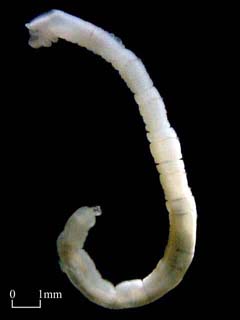Order Capitellida
Family Maldanidae
Features |
| Body: |
long and cyclindrical; usually truncate at
one or both ends; most with long, cylindrical segments |
| Prostomium: |
with a pair of nuchal slits and a median
cephalic keel; no appendage |
| Eye: |
absent |
| Antennae: |
absent |
| Cirri: |
absent |
| Palp: |
absent |
| Pharynx: |
non-eversible |
| Parapodium: |
biramous; notopodia short and rounded;
neuropodia elongated tori |
| Setea: |
notosetae smooth or spinose capillaries;
neurosetae rostrate hooks |
| (Fauchald 1977) |
Biological Notes
Maldanids are also called bamboo-worms. They are highly
specialised burrowers and feed on organic particles in the mud. They burrow
head downward and the surrounding materials are cemented together to form a compact
tube. The pygidium plugs the entrance of the tube and the anal cirri may be
sensory. Burrowing is assisted by peristalic action of the elongated and
highly contractile segments. The water current is forced down from the tail
towards the head that aids in feeding. Clymenella and Praxillella
burrow in open sandbanks and their tubes are easily broken. Maldane can be
found in softer muds and its tube is usually large. The eggs of maldanids are
incubated in mucus cocoons which are attached to the entrance of the burrow.
The larvae escape at final stage of development (Day 1967).
Genera and Species Reported in Hong Kong
Axiothella sp.
Clymenella sp.
Maldane sarsi
Praxillella gracilis |
